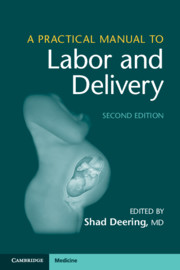Book contents
- A Practical Manual to Labor and Delivery
- A Practical Manual to Labor and Delivery
- Copyright page
- Dedication
- Contents
- Contributors
- Preface
- Acknowledgments
- Abbreviations
- Chapter 1 Introduction and Basic Principles
- Chapter 2 Common Examinations and Procedures
- Chapter 3 Intrapartum Fetal Heart Rate Monitoring
- Chapter 4 Management of the First Stage of Labor
- Chapter 5 Management of the Second Stage of Labor
- Chapter 6 Management of the Third Stage of Labor
- Chapter 7 Induction and Augmentation of Labor
- Chapter 8 Obstetric Analgesia and Anesthesia
- Chapter 9 Operative Vaginal Delivery
- Chapter 10 Cesarean Delivery
- Chapter 11 Lacerations and Episiotomies
- Chapter 12 Neonatal Resuscitation
- Chapter 13 Postpartum Care
- Chapter 14 Common Obstetric Complications and Emergencies
- Book part
- Index
- References
Chapter 14 - Common Obstetric Complications and Emergencies
Published online by Cambridge University Press: 03 September 2018
- A Practical Manual to Labor and Delivery
- A Practical Manual to Labor and Delivery
- Copyright page
- Dedication
- Contents
- Contributors
- Preface
- Acknowledgments
- Abbreviations
- Chapter 1 Introduction and Basic Principles
- Chapter 2 Common Examinations and Procedures
- Chapter 3 Intrapartum Fetal Heart Rate Monitoring
- Chapter 4 Management of the First Stage of Labor
- Chapter 5 Management of the Second Stage of Labor
- Chapter 6 Management of the Third Stage of Labor
- Chapter 7 Induction and Augmentation of Labor
- Chapter 8 Obstetric Analgesia and Anesthesia
- Chapter 9 Operative Vaginal Delivery
- Chapter 10 Cesarean Delivery
- Chapter 11 Lacerations and Episiotomies
- Chapter 12 Neonatal Resuscitation
- Chapter 13 Postpartum Care
- Chapter 14 Common Obstetric Complications and Emergencies
- Book part
- Index
- References
- Type
- Chapter
- Information
- A Practical Manual to Labor and Delivery , pp. 198 - 240Publisher: Cambridge University PressPrint publication year: 2018



